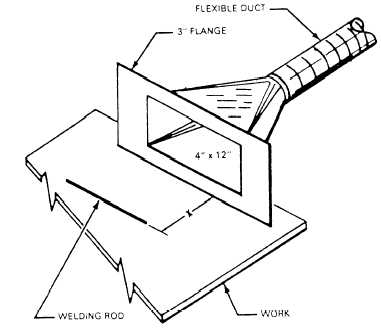| |
Figure 3-1.—Local exhaust ventilation.
Administrative Control
Administrative control emoploys special operating
procedures to reduce the exposure of personnel to
hazards. Examples include procedures that limit access
to high hazard areas and that provide for adjusted work
schedules such as heat stress safe stay times. Another
example is an operating procedure requiring the use of
semiautomatic equipment that does not require constant
attendance (time separation). Adjusted work schedules
should be used only when personnel maybe repeatedly
exposed to the hazard without adverse effect.
Personal Protective Equipment
The use of personal protective equipment (PPE) is
the least preferred method of hazard control. With this
method, any equipment breakdown, failure, or misuse
immediately exposes the wearer to the hazard. The
effectiveness of the PPE also depends on the conscious
effort of the user to wear it properly. Nevertheless, when
other methods cannot achieve adequate risk reduction,
personal protective devices must be used, either alone
or in conjunction with other protective measures.
HAZARD IDENTIFICATION
Hazard identification occurs through observation
and routine safety program evaluations, surveys, and
formal inspections. The safety officer, safety manager,
safety petty officer, or safety supervisor trains people to
recognize hazards. In chapters 6, 7, and 8, we discuss
the program evaluation and hazard identification
process for shore, afloat, and aviation activities.
HAZARD REPORTING
The earliest possible detection of unsafe or
unhealthful working conditions and the prompt control
of hazards identified as a result of those conditions are
essential. Encourage your subordinates to submit
promptly a report of unsafe or unhealthful conditions.
All personnel should orally report unsafe or
unhealthful working conditions to their immediate
supervisor. That supervisor should promptly evaluate
the situation and take appropriate corrective actions.
Supervisors will contact the Occupational Safety and
Health (OSH) office, safety manager, division safety
petty officer, division officer, or safety officer for
assistance, if needed. The person reporting the hazard
must be kept informed of all actions taken.
After personnel orally report an unsafe or
unhealthful condition, they may expect the supervisor
to investigate the situation. If their supervisor takes no
action to investigate the condition or they are unsatisfied
with the result, personnel may submit a written report.
Ashore, the poster, DD Form 2272, DOD
Occupational Safety and Health Protection Program,
reminds employees that hazard reporting is their
3-7
|

